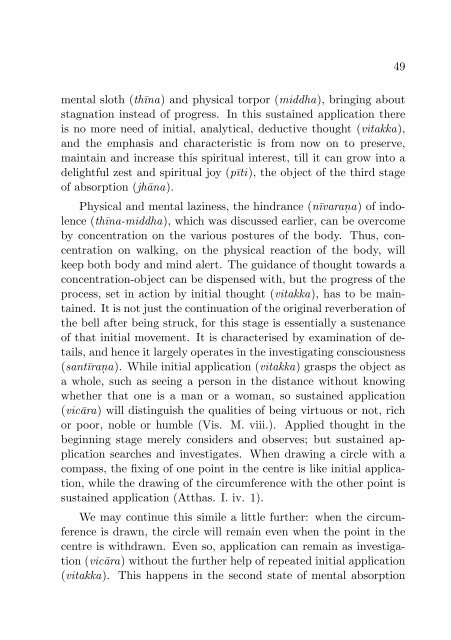Agony and Ecstasy
A comparative study of the five hindrances, together with the five states of concentration or mental absorption.
A comparative study of the five hindrances, together with the five states of concentration or mental absorption.
You also want an ePaper? Increase the reach of your titles
YUMPU automatically turns print PDFs into web optimized ePapers that Google loves.
49<br />
mental sloth (thīna) <strong>and</strong> physical torpor (middha), bringing about<br />
stagnation instead of progress. In this sustained application there<br />
is no more need of initial, analytical, deductive thought (vitakka),<br />
<strong>and</strong> the emphasis <strong>and</strong> characteristic is from now on to preserve,<br />
maintain <strong>and</strong> increase this spiritual interest, till it can grow into a<br />
delightful zest <strong>and</strong> spiritual joy (pīti), the object of the third stage<br />
of absorption (jhāna).<br />
Physical <strong>and</strong> mental laziness, the hindrance (nīvaraṇa) of indolence<br />
(thīna-middha), which was discussed earlier, can be overcome<br />
by concentration on the various postures of the body. Thus, concentration<br />
on walking, on the physical reaction of the body, will<br />
keep both body <strong>and</strong> mind alert. The guidance of thought towards a<br />
concentration-object can be dispensed with, but the progress of the<br />
process, set in action by initial thought (vitakka), has to be maintained.<br />
It is not just the continuation of the original reverberation of<br />
the bell after being struck, for this stage is essentially a sustenance<br />
of that initial movement. It is characterised by examination of details,<br />
<strong>and</strong> hence it largely operates in the investigating consciousness<br />
(santīraṇa). While initial application (vitakka) grasps the object as<br />
a whole, such as seeing a person in the distance without knowing<br />
whether that one is a man or a woman, so sustained application<br />
(vicāra) will distinguish the qualities of being virtuous or not, rich<br />
or poor, noble or humble (Vis. M. viii.). Applied thought in the<br />
beginning stage merely considers <strong>and</strong> observes; but sustained application<br />
searches <strong>and</strong> investigates. When drawing a circle with a<br />
compass, the fixing of one point in the centre is like initial application,<br />
while the drawing of the circumference with the other point is<br />
sustained application (Atthas. I. iv. 1).<br />
We may continue this simile a little further: when the circumference<br />
is drawn, the circle will remain even when the point in the<br />
centre is withdrawn. Even so, application can remain as investigation<br />
(vicāra) without the further help of repeated initial application<br />
(vitakka). This happens in the second state of mental absorption

















